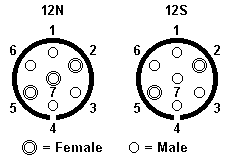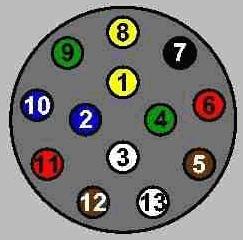Here are the pin outs for UK standard 12N and 12S plug / socket

Viewed from rear of plug.
The 12N socket is used by most trailers and caravans in the UK. The 12S is used only by caravans. Some cars are fitted with factory tow bars from Europe and come fitted with a single 13 pin socket that combines most of the 12N and 12S signals into one socket. The 13 pin socket is now taking over from the 12N and 12S.
The 12N sockets are fairly simple. The pin out is: –
1: Yellow: Left indicator
2: Blue: Fog lamp (permanent live on very old cars / caravans)
3: White: Chassis earth
4: Green: Right indicator
5: Brown: Right tail and number plate light
6: Red: Brake lights
7: Black: Left tail
Some sockets have an eighth connection on the back. The idea is that you break the circuit to the rear fog light(s) on the car, and feed them from the eighth connection. When a trailer plug is inserted it switches out this connection thus killing the car’s fog light. A much better idea is to feed the car’s fog light through a load sensing relay. If the trailer’s fog light circuit is complete and presenting a load then the relay switches out the car’s fog light, but if it isn’t present or the bulb has blown then the car’s fog light still illuminates. This gives a convenient warning that the trailer / caravan’s fog light is not working if when the fog lights are switched on the car’s fog light can be seen glaring on the front of the trailer / caravan.
Some newer cars have bulb failure detection and others send a voltage to some of the bulbs all of the time. In these cases a relay box or an intelligent switch is needed, powering the trailer lights from a permanent live source through the relays / switch. In any case legally a dashboard light or a buzzer is needed to detect whether or not trailer indicators are functioning, and a heavy duty flasher relay may be needed.
The 12S socket is more difficult because the functions changed during 1998. Some caravans that are pre 1998 are wired the new way too.
The pin out is:-
1: Yellow: Reversing light
2: Blue: Switched live feed for battery charge (pre1998)
3: White: Chassis earth
4: Green: Permanent live feed for interior lights / battery charge (switched by caravan)
5: Brown: Sensing device / spare
6: Red: Switched live feed for fridge
7: Black: Chassis earth for fridge (not present on some old cars / caravans)
Pin 4 has always been permanent live. On old caravans only a low current was needed because it was used for interior lights. However on post 1998 caravans a much thicker cable is needed on the car that can supply at least 16 amps. Connecting a new caravan to an old car can overload pin 4 if the installer has used light gauge wire to an inappropriate 12V source. Occasionally a new caravan will be found that has pins 2 and 3 shorted.
This then blows out the permanent feed to pin 2 if it is present…. If
you wire up pin 2 for compatibility with old caravans then please fuse it. In fact fuse everything.
On pre 1998 caravans pin 2 was a simple 16 amp switched feed that would charge the caravan battery if the engine is running.
On post 1998 caravans pin 2 is not used. A relay connects the caravan battery to the live feed from pin 4, and disconnects the caravan lights.
The relay is triggered by the fridge circuit.
In order to wire a car for both old and new standards, you must use a 16 amp switched feed for pin 2 and a 16 amp permanent feed for pin 4, and then another 16 amp switched feed for pin 6 which is the fridge, then a 35 amp earth on pin 3 (earths both fridge and battery on old caravans) and a 16 amp earth on pin 7 (for earthing the fridge on newer caravans). That’s quite a lot of thick
cables….
The correct way to wire the car is to run new cables all the way to the battery (through a new separate fuse box). The switched feeds (pin 2 and 6 for old caravans, pin 6 for new) need to go through a relay. The relay needs to be triggered only when the engine is running, sometimes this can be achieved by triggering from the alternator warning light circuit, or by finding something that only works when the engine is running (like the blower motor on
some Peugeots). Powering the caravan circuits from power sources in the car that were not intended for that purpose (such as the boot light) might seem easier, but can prove costly if the car’s wiring is damaged by a load that it was not intended for.
Remember that 12S uses a thicker cable (2.5mm) than 12N, even though the colours are the same.
13 pin Euro plug / socket

Viewed from rear of socket
2: Blue: Fog light
3: White: Chassis earth for lights
4: Green: Right indicator
5: Brown: Right tail and number plate light
6: Red: Stop lamp
7: Black: Left tail
8: Orange: Reversing light
9: Brown/Blue: Permanent live feed for interior lights / battery charge (switched by caravan)
10: Brown/Red: Switched live feed for fridge
11: White/Blue: Chassis earth for fridge
12: Spare
13: White/Green: Chassis earth for charging / lights
Again, newer caravan will charge the battery off pin 9 through a relay that is triggered from pin 10.

